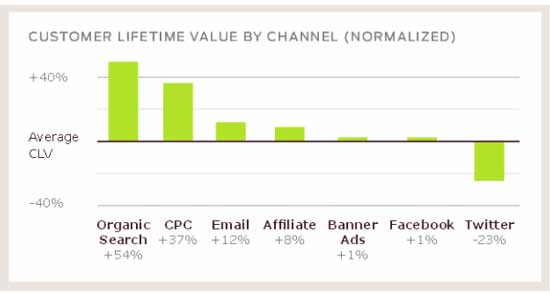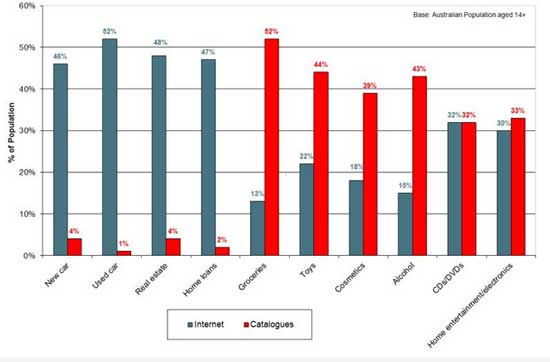Retailers feeling inadequate because they haven’t yet developed a ‘social commerce’ strategy will take heart from a recent report indicating plain ol’ email is a far superior sales medium than Twitter or Facebook.

And the venerable colour catalogue also remains an effective sales tool.
While Twitter and Facebook have their uses, direct sales isn’t apparently one of them, with US-based marketing data company Custora claiming that online retailers have quadrupled the rate of customers acquired via email (to a modest 7 percent) while Facebook barely registers as a sales medium and shows no signs of growing.
Twitter has had no sales impact at all.
Outstripping both email and social networking are both ‘organic searches’ and cost-per-click ads.
Custora analysed data from 72 million customers shopping on 86 different retailer sites. They tracked where customers were clicking from (email, Twitter, Google, etc.) and what and how much they bought, not just on that visit but for the next two years.
It was discovered that customers who came to retailers from a search were more than 50 percent more valuable than average – shopping more and spending more. (Not surprising, in that the customer was taking the initiative rather than having an offer pushed at them.) Email customers were nearly 11 percent more valuable than average. Facebook-derived customers were just about average, while Twitter-derived customers were 23 percent less valuable than average during the two years following that first click.
‘I wouldn’t necessarily say Twitter is inherently a bad way to do (online marketing), but we haven’t seen a lot of good Twitter strategies right now,’ Aaron Goodman, Custora’s lead data scientist told technology website, Wired. He said that Twitter marketing campaigns tend to rely on someone running across a deal they like when they dip into their feed. Even if they do see it, within seconds it disappears.
Email, on the other hand, has a certain advantage in that shoppers getting the emails have supplied their addresses to a site, suggesting they already have some prior relationship with that retailer.
Personalisation and the lack of restrictions on images and text content – you can use more than 140 characters – gives email further advantages.
Custora’s findings indicate that retailers would be better advised to put their efforts into building a customer email address list and developing their email marketing strategy rather than putting a lot of effort into a Facebook page or Twitter account.
Facebook and Twitter have the potential to raise awareness of a brand or a specific product, but less in the way of selling power. Custora found that Google searches and internet ads, by contrast, not only lead to clicks but to purchases.
Facebook and Twitter are also double-edged swords in that customers can talk back. This is great when they are waxing lyrical about your products or customer service, but as Canon among others has discovered recently, it can also provide a platform for customers to share negative comments about your products and services – paid for out of your marketing communications dollars!
Cattle dogs will round them up
– And in the hierarchy of sales media, while emails trump Facebook, catalogues trump the lot!
Research from AMP Capital’s 2012 Shopping Intent Report showed 37 percent of (Australian) respondents ranked catalogues as the most influential channel, compared to television, search engines, retailer websites, email alerts, product review websites and manufacturers’ websites.
Even among younger people, 28 percent of 18 to 24-year-olds and 30 percent of 25 to 34-year-olds nominated catalogues as the most influential.
Colour catalogues are closely followed by television (34 per cent) and letter box drops (30 percent – catalogues + delivery?), showing these long-established marketing techniques remain persuasive.
According to the report, the top online influencers on purchases include:
– Search engines (24 per cent);
– Retailer websites (19 per cent);
– Email alerts (17 per cent);
– Professional product review websites eg, Photo Review (17 per cent);
– Manufacturers’ websites (16 per cent).
While only 8 per cent of consumers surveyed said Facebook affected their purchasing
decisions, this rose to a quarter of the of shoppers aged 18-24 year olds.
Digging even deeper into the catalogue versus internet issue, Roy Morgan Research, in a survey of 50,000 Australians, has identified which categories of product consumers prefer to research via internet compared to catalogues.

For expensive items like new and used cars and real estate, the internet is where people prefer to start. Researching real estate is another example of when Australians prefer to go online. Many people also use it to source information about home (or other) loans, insurance, and purchasing computers (43 percent).
But despite its popularity, the internet is not the one-stop shop it’s often made out to be. Australians still find printed catalogues more useful when they’re considering certain kinds of purchases: groceries (51 percent), toys (43 percent), kids’ clothing (42 percent) and cosmetics (38 percent), to name a few.
Interestingly, given the growing popularity of online fashion shopping, more Australians (38 percent) prefer to look at catalogues when considering clothing purchases than the internet (21 percent). Catalogues also reign supreme for Aussies looking to buy alcohol: 43 percent consider them the most useful source of information, with the internet a distant second (15 percent).
For other product categories, preferences aren’t so clear cut. For example, CDs and DVDs, home interiors and furnishings and home entertainment and electronics – the category which we assume includes photographic gear – its a close-run thing.





Be First to Comment